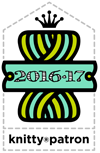Feature: Our Knitting Roots: a study of the contributions immigrants have made to North American knitting, by Donna Druchunas
INTRODUCTION
Our Knitting Roots
by Donna Druchunas
It may be difficult to look at a sock or mitten that you’ve made with your own hands and feel a connection to a group of people who seem strange or foreign to you. But as knitters and as humans, we owe it to ourselves and to each other to forge these unlikely connections. Making things by hand, after all, is an intimate human endeavor and we should use it not only to knit strings into socks or sweaters or shawls, but also to knit person to person, strangers into friends.
In Harry Potter and the Sorcerer’s Stone, J.K. Rowling wrote, “There are some things you can’t share without ending up liking each other, and knocking out a twelve-foot mountain troll is one of them.”
Knitting is another.
This issue: Passing Down Knitting Traditions
One of my favorite things about knitting is that it can be used—admittedly like many other crafts—to pass down traditions from generation to generation and even from era to era. We can connect to our roots when we have heirlooms (or even junk that has sentimental value) passed down through our families, we can connect to the larger world when we buy items that have been inspired by traditional designs, and we can connect to people throughout history by learning their techniques and patterns and making them new again.
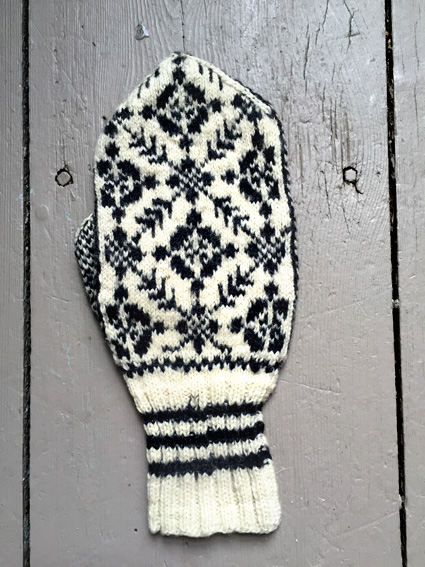 One way traditions get passed down is when objects are passed down from person to person, individually. In 2014, I received a surprise package in the mail. The return address said it was from someone named Denyce, V——. The name was not familiar to me. When I opened the box, I discovered that it was full of vintage Norwegian mittens from the collection of Linda Mercer.
One way traditions get passed down is when objects are passed down from person to person, individually. In 2014, I received a surprise package in the mail. The return address said it was from someone named Denyce, V——. The name was not familiar to me. When I opened the box, I discovered that it was full of vintage Norwegian mittens from the collection of Linda Mercer.
When Linda passed away in 2010, her husband sold some of her knitting and spinning collection at the Handweavers Guild of Boise Valley, where Linda had been a member. These mittens were passed on to Denyce. And now they were finding their way to me. Denyce wrote, “I have a number of beautiful gloves that [Linda Mercer] purchased in Europe that I would like to forward on to [you]. I have taken a number of classes from [you] and thought [you] would like to look at them and perhaps get some ideas.” Yes, I’ve had ideas. The mittens in this column (see below) are one of them.
Linda Mercer not only collected vintage knitting pieces, but she also loved knitting mitts and wash cloths to sell for her “Run for the Cure” team, raising money for Breast Cancer. She was published in the Black Sheep Newsletter and Spin-Off magazine, and Spin-Off declared her the world’s finest mohair handspinner for yarn that was 28,225 yards per pound. (That’s over 3,000 yards of singles yarn in 50 grams!) Linda also raised angora goats, specializing in breeding goats with colored fiber. She and her husband led tours of their farm and Linda taught felting, weaving, and spinning workshops.
I’ve been inspired by Linda Mercer ever since I first heard about work when I was learning to spin and dye yarn over 20 years ago. Linda will continued to be sorely missed in the spinning and knitting world for years to come. This pattern and essay are dedicated to her memory.
Another way traditions get passed down is when knitted items are turned into commercial products. When you think of Norwegian knitting, do you think of ski sweaters and mittens with snowflake designs on them? If you do, you're not alone. Several of today's popular knitting designs originated in Norway in the 19th century and became popular around the world when Dale of Norway began creating spectacular sweaters for the Norwegian Winter Olympics teams in 1956. Today the company sells both sweaters and knitting yarns and patterns in both traditional and contemporary styles, and is also supplies sweaters to the U.S. Olympic ski team.
The handknit sweaters that we all love today weren't always popular in Norway, however. When rural knitters first started making them, people from the towns and cities looked down on these garments as peasant clothes. Farmers didn't care much about fashion, and since wool was readily available in rural areas, it was put to use to keep bodies warm in cold winter weather, regardless of what the city-slickers thought. Soon enough, however, the designs spread in popularity until they eventually became symbols of Norway known throughout the world.
A third way traditions get passed down is when we, as knitters, appreciate knitting techniques from around the world and share them with others. When I think of Norway, the first thing that comes to my mind after sweaters is mittens. A while back I went through a mitten knitting phase and made nothing but mittens for two years. I still have a huge basket full of mittens, even though I gave a pair to everyone who visited my house during that time and mailed packages of mittens out to all of my friends and relatives at Christmas. I loved making mittens because they are small projects that make it fun to try out new stitches and techniques without committing yourself to the months—or even years—of knitting that go into making a sweater.
My favorite mittens to knit were in the Norwegian style, with the pointed finger tips and two-color patterns that fit neatly onto the shape of the hand. In her book, Selbuvotter: Biography of a Knitting Tradition, Terri Shea explains how the classic black-and-white snowflake mitten was created in the Selbu district of Norway by an intrepid knitter named Marit Guldseth. Marit had seen a friend knit a simple two color pattern into a pair of stockings, and she wanted to try it out on mittens. After a summer of experimentation, when she was just sixteen years old, Marit made a pair of snowflake patterned mittens and wore them to church on the first cold Sunday of the winter.
The rest, as they say, is history.
Learn More
- Next Steps in Fair Isle Class on Craftsy by Donna Druchunas. Another pair of mittens from Linda Mercer’s collection to inspired the Caribou and Snow mittens and hat projects that are featured in this course.
- Selbuvotter: Biography of a Knitting Tradition by Terri Shea tells the history of the popular black-and-white mittens of Norway and includes charts and patterns for many traditional designs.
INTRODUCTION
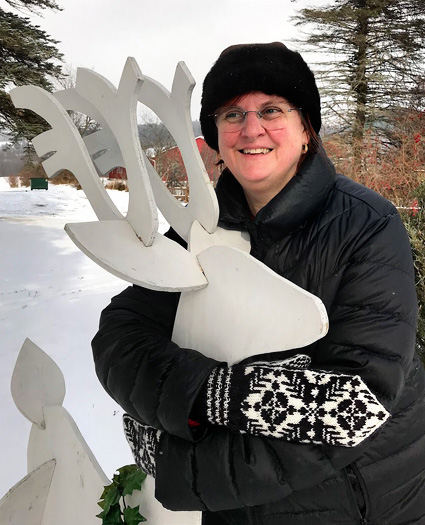 by Donna Druchunas
by Donna Druchunas
![]()
These mittens are inspired by traditional black-and-white colorwork mittens made in the Selbu region of Norway. Typically, Selbu mittens are usually made with white as the main color and black as the contrasting color. A complex design fills the entire back of the hand and a smaller all-over pattern is worked on the palm. A thumb gore that makes extra room for the base of the thumb is also decorated with an intricate pattern that is carried up the visible part of the thumb.
I wanted the design to look less feminine or flowery and more graphic, so I switched the placement of black and white yarn in some sections to create a strong geometric background of diamonds. I also like the palm of mittens to be “rest rows” – like WS rows are in texture or lace knitting – so I used a very simple 2-stitch, 4-row repeat that can be knit without referring back to a chart.
 model: Donna Druchunas
model: Donna Druchunas
 photos: Dominic Cotignola
photos: Dominic Cotignola
SIZE
Adult: S[M, L]
shown in Medium
FINISHED MEASUREMENTS
With yarn and needles specified for size
Length with cuff: 11[12, 13] in/ 28[30.5, 33] cm
Length of hand: 11[8 1/2, 13] in/ 28[30.5, 33] cm
Circumference: 7[8, 9] in/ 18[20.5, 23] cm
Sizing notes: Because of the overall pattern on the back of the hand and thumb, these mittens are not easily resized. Traditionally the mittens were made in one size only. Because ModeWerk yarn comes in many different weights, I suggest changing yarn weight, needle size, and gauge to obtain the desired size without cutting off part of the hand pattern.
These mittens have a thumb gore that allows for a snug fit if desired. Choose the size that best matches the measurement around your hand just below the knuckles where your fingers join your hand. The length of these mittens is not adjustable without recharting the entire thumb and hand, so check your row gauge and select the size that is slightly longer than the measurement. If you are in between sizes, choose the larger option.
MATERIALS/GAUGE
Note: The pattern uses needles smaller than suggested on the ball band to get smaller stitches for better stitch definition and warmer mittens.
SMALL
Yarn
ModeKnit Yarns ModeWerk Fingering [80% merino/20% nylon; approx 400 yd per 100g skein];
![]() [MC] 001 Pearl; 1 skein
[MC] 001 Pearl; 1 skein
![]() [CC] 014 Coal; 1 skein
[CC] 014 Coal; 1 skein
![]() US #00/1.75mm needles for small circumference in the round
US #00/1.75mm needles for small circumference in the round
![]() US #0/2mm needles for small circumference in the round
US #0/2mm needles for small circumference in the round
GAUGE
37 sts/32 rounds = 4 inches/10 cm in stockinette stitch with stranded colorwork using larger needles
28 sts/40 rounds = 4 inches/10 cm in single-color stockinette stitch using US#1/2.25mm needles
MEDIUM
Yarn
ModeKnit Yarns ModeWerk DK [100% merino; approx 232 yd per 100g skein];
![]() [MC] 001 Pearl; 1 skein
[MC] 001 Pearl; 1 skein
![]() [CC] 014 Coal; 1 skein
[CC] 014 Coal; 1 skein
![]() US #1/2.25mm needles for small circumference in the round
US #1/2.25mm needles for small circumference in the round
![]() US #2/2.75mm needles for small circumference in the round
US #2/2.75mm needles for small circumference in the round
GAUGE
33 sts/28 rounds = 4 inches/10 cm in stockinette stitch with stranded colorwork using larger needles
22 sts/30 rounds = 4 inches/10 cm in single-color stockinette stitch using US#5/3.75mm needles
LARGE
Yarn
ModeKnit Yarns ModeWerk Worsted [100% merino; approx 218 yd per 100gr skein];
![]() [MC] 001 Pearl; 1 skein
[MC] 001 Pearl; 1 skein
![]() [CC] 014 Coal; 1 skein
[CC] 014 Coal; 1 skein
![]() US #3/3.25mm needles for small circumference in the round
US #3/3.25mm needles for small circumference in the round
![]() US #4/3.5mm needles for small circumference in the round
US #4/3.5mm needles for small circumference in the round
GAUGE
29 sts/25 rounds = 4 inches/10 cm in stockinette stitch with stranded colorwork using larger needles
20 sts/28 rounds = 4 inches/10 cm in single-color stockinette stitch using US#7/4.5mm needles
Notions - All Sizes
![]() stitch markers
stitch markers
![]() tapestry needle
tapestry needle
PATTERN NOTES
[Knitty's list of standard abbreviations and techniques can be found here.]
CHART
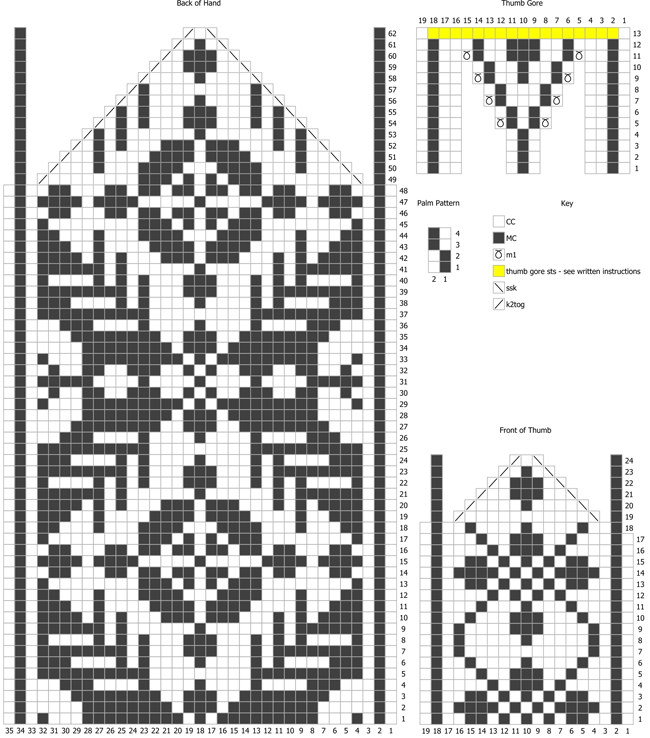
DIRECTIONS

With MC and smaller needles for your size, using the long-tail method, CO 56 sts. Join to work in the round being careful not to twist.
Cuff
Ribbing rnd: [K2, p2] around.
Work ribbing as set for 13 rnds.
[Change to CC. Work 2 rounds ribbing in CC. Change to MC. Work 2 rounds ribbing in MC.] 3 times.
Change to MC. Work 2 more rounds in ribbing.
Change to larger needles for your size.
Next rnd, increase: (K14, m1) 4 times. 60 sts.
Knit 1 rnd.
Lower Hand and Thumb Gore
Note: Left and Right mittens have different placement of thumb gore. Place markers between sections or divide sections on separate ndls, as you prefer.
Setup rnd (right mitten only): Work 35 sts of Back of Hand chart including side panels, work 11 sts of Thumb Gore chart, work Palm Pattern chart over next 14 sts.
Setup rnd (left mitten only): Work 35 sts of Back of Hand chart including side panels, work Palm Pattern chart over next 14 sts, work 11 sts of Thumb Gore chart.
Continue in patterns as set until rnd 12 of Thumb Gore chart is complete—19 sts in thumb gore, 69 sts total.
Next rnd: Work patterns as set to Thumb Gore. K1 CC, place next 17 sts on hold to work thumb later, using backwards-loop cast on CO 1415 sts alternating between MC and CC to establish Palm Pattern as set on remainder of hand, k1 CC, finish rnd as set—66 sts.
Upper Hand
Continue to work in patterns as set until rnd 48 of Back of Hand chart is complete.
Fingertip Shaping
Setup: k1 and then slip this stitch to the end of the round. Slip last stitch of Back of Hand chart/section to Palm section. These 2 sts are now part of the Palm, and will be used for the decreases.
Rnd 1: Work Back of Hand chart as set (with new start of round, starting on the previous 2nd stitch of the chart); on palm, with CC ssk, work in Palm Pattern as set to last 2 sts of palm, with CC k2tog.
Continue as set until row 62 of Back of Hand Chart is complete. 8 sts rem.
Cut yarns and use tapestry needle to draw tails through remaining sts. Gather together to fasten off.
Thumb
Return held Thumb Gore sts to smaller needles. Rejoin CC and pick up and knit 1 st with at side of thumb opening, pick up and knit 14 sts in colors to match patt as set across top of thumb opening, pick up and knit 1 st with CC at second side of thumb opening. The first and last picked up sts become part of the Front of Thumb. 33 sts; 19 for Front and 14 for Back.
Work Front of Thumb as charted and Back of Thumb as set in Palm Pattern. Decrease and fasten off as for Finger Tip Shaping, following Thumb Chart for Front of Thumb and continuing in Palm Pattern on Back of Thumb. 7 sts rem.

FINISHING
Weave in ends, tightening any loose stitches at the base of the thumb.
Wash and dry flat to block. If necessary, press lightly through a towel with steam to flatten stitches.
ABOUT THE DESIGNER
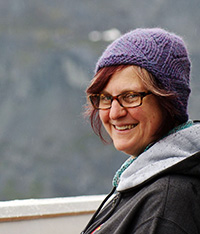 Donna Druchunas is obsessed with her family history and the history of knitting. In addition to writing this column about Our Knitting Roots, she is also running a book club for knitters who want learn to appreciate the people, places, and cultures behind the stitches of their knitting projects. She is the author of many knitting books including her newest titles: How to Knit Socks that Fit and Lithuanian Knitting: Continuing Traditions. Donna has taught knitting workshops in the United States, Canada, and Europe and she has five knitting classes on Craftsy.
Donna Druchunas is obsessed with her family history and the history of knitting. In addition to writing this column about Our Knitting Roots, she is also running a book club for knitters who want learn to appreciate the people, places, and cultures behind the stitches of their knitting projects. She is the author of many knitting books including her newest titles: How to Knit Socks that Fit and Lithuanian Knitting: Continuing Traditions. Donna has taught knitting workshops in the United States, Canada, and Europe and she has five knitting classes on Craftsy.
Her newest project is opening a small local yarn shop in rural Vermont where lives she with her husband, mother, three cats and a long-haired Chihuahua. Visit Donna's website.
Text, pattern & images © 2017 Donna Druchunas. Contact Donna




